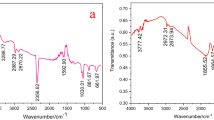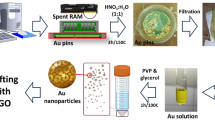Abstract
The efficient removal of heavy metals from aqueous environment is imperative and challenging. A novel ternary composite constructed of diaminopyridine polymers, graphene oxide, and ferrite magnetic nanoparticles was designed by a facile in situ polymerization strategy for the removal of Pb(II) from aqueous solution. Detailed characterization of morphological, chemical, and magnetic properties was employed systematically to confirm the formation of the composite material. Batch adsorption experiment studies suggested that the composite was an excellent adsorbent for Pb(II) which was easily collected after use via exposure to an external magnetic field for 30 s. The effects of different parameters such as solution pH, adsorbent dosage, contact time, initial Pb(II) concentration, temperature, and co-existing ions were examined. The maximum adsorption capacity at pH = 5 was estimated to be 387.2 mg g−1 at 298 K by the Langmuir isotherm model, accompanied by favorable adsorption recyclability according to the investigation of regeneration experiments. Thermodynamic studies revealed that the Pb(II) adsorption via our ternary composite was endothermic and spontaneous. The corresponding removal performance for effluent containing Pb(II) from the battery industry was successfully examined. The present results indicated that our designed adsorbent is beneficial to the practical Pb(II) removal in wastewater purification.








Similar content being viewed by others
References
Acharya J, Sahu JN, Mohanty CR (2009) Removal of lead(II) from wastewater by activated carbon developed from Tamarind wood by zinc chloride activation. Chem Eng J 149:249–262
Aguado J, Arsuaga JM, Arencibia A (2009) Aqueous heavy metals removal by adsorption on amine-functionalized mesoporous silica. J Hazard Mater 163:213–221
Barton TJ, Bull LM, Klemperer WG (1999) Tailored porous materials. Chem Mater 11:2633–2656
Chella S, Kollu P, Komarala EVPR, Doshi S (2015) Solvothermal synthesis of MnFe2O4-graphene composite-Investigation of its adsorption and antimicrobial properties. Appl Surf Sci 327:27–36
Chen LY, Xu ZX, Dai H (2010) Facile synthesis and magnetic properties of monodisperse Fe3O4/silica nanocomposite microspheres with embedded structures via a direct solution-based route. J Alloys Compd 497:221–227
Chen B, Chen S, Zhao H (2019) A versatile beta-cyclodextrin and polyethyleneimine bi-functionalized magnetic nanoadsorbent for simultaneous capture of methyl orange and Pb(II) from complex wastewater. Chemosphere 216:605–616
Cui LM, Wang YG, Gao L (2015) EDTA functionalized magnetic graphene oxide for removal of Pb(II), Hg(II) and Cu(II) in water treatment: adsorption mechanism and separation property. Chem Eng J 281:1–10
Danesh N, Hosseini M, Ghorbani M, Marjani A (2016) Fabrication, characterization and physical properties of a novel magnetite graphene oxide/lauric acid nanoparticles modified by ethylenediaminetetraacetic acid and its applications as an adsorbent for the removal of Pb(II) ions. Synth Met 220:508–523
Dinda D, Kumar SS (2015) Sulfuric acid doped poly diaminopyridine/graphene composite to remove high concentration of toxic Cr(VI). J Hazard Mater 291:93–101
Dinda D, Gupta A, Saha SK (2013) Removal of toxic Cr (VI) by UV-active functionalized graphene oxide for water purification. J Mater Chem A 1:11221–11228
Dong SY, Cui YR, Wang YF (2014) Designing three-dimensional acicular sheaf shaped BiVO4/reduced graphene oxide composites for efficient sunlight-driven photocatalytic degradation of dye wastewater. Chem Eng J 249:102–110
Dong SY, Ding XH, Guo T (2017) Self-assembled hollow sphere shaped Bi2WO6/RGO composites for efficient sunlight-driven photocatalytic degradation of organic pollutants. Chem Eng J 316:778–789
Ebrahimzadeh H, Moazzen E, Amini MM (2013) Pyridine-2,6-diamine-functionalized Fe3O4 nanoparticles as a novel sorbent for determination of lead and cadmium ions in cosmetic samples. Int J Cosmet Sci 35:176–182
Fan LL, Luo CN, Sun M (2013) Highly selective adsorption of lead ions by water-dispersible magnetic chitosan/graphene oxide composites. Colloids Surf B: Biointerfaces 103:523–529
Fatemeh EP, Bahramifar N, Younesi H (2018) Removal of Cd (II), Pb (II) and Cu (II) ions from aqueous solution by polyamidoamine dendrimer grafted magnetic graphene oxide nanosheets. J Taiwan Inst Chem Eng 87:225–240
Ferrari AC, Meyer JC, Scardaci V (2006) Raman spectrum of graphene and graphene layers. Phys Rev Lett 97:187401–187404
Fu W, Huang ZQ (2018) Magnetic dithiocarbamate functionalized reduced graphene oxide for the removal of Cu(II), Cd(II), Pb(II), and Hg(II) ions from aqueous solution: Synthesis, adsorption, and regeneration. Chemosphere 209:449–456
Guo XY, Du B, Wei Q (2014) Synthesis of amino functionalized magnetic graphenes composite material and its application to remove Cr(VI), Pb(II), Hg(II), Cd(II) and Ni(II) from contaminated water. J Hazard Mater 278:211–220
Guo SZ, Duan N, Dan ZG (2018a) Three-dimensional magnetic graphitic carbon nitride composites as high-performance adsorbent for removal Pb2+ from aqueous solution. J Taiwan Inst Chem Eng 89:169–182
Guo SZ, Duan N, Dan ZG (2018b) g-C3N4 modified magnetic Fe3O4 adsorbent: preparation, characterization, and performance of Zn(II), Pb(II) and Cd(II) removal from aqueous solution. J Mol Liq 258:225–234
Hao LY, Song HJ, Zhang LC (2012) SiO2/graphene composite for highly selective adsorption of Pb(II) ion. J Colloid Interface Sci 369:381–387
Hu HB, Wang ZH, Pan L (2010) Synthesis of monodisperse Fe3O4@silica core–shell microspheres and their application for removal of heavy metal ions from water. J Alloys Compd 492:656–661
Hu LH, Yang ZP, Cui LM (2016) Fabrication of hyperbranched polyamine functionalized graphene for high-efficiency removal of Pb(II) and methylene blue. Chem Eng J 287:545–556
Hua M, Zhang SJ, Pan BC (2012) Heavy metal removal from water/wastewater by nanosized metal oxides: a review. J Hazard Mater 211-212:317–331
Huang LJ, He M, Chen BB (2018) Magnetic Zr-MOFs nanocomposites for rapid removal of heavy metal ions and dyes from water. Chemosphere 199:435–444
Hummers WS Jr, Offeman RE (1958) Preparation of Graphitic Oxide. J Am Chem Soc 80:1339
Jiang LL, Li SJ, Yu HT (2016) Amino and thiol modified magnetic multi-walled carbon nanotubes for the simultaneous removal of lead, zinc, and phenol from aqueous solutions. Appl Surf Sci 369:398–413
Ke F, Jiang J, Li YZ (2017) Highly selective removal of Hg2+ and Pb2+ by thiol-functionalized Fe3O4@metal-organic framework core-shell magnetic microspheres. Appl Surf Sci 413:266–274
Khan AA, Singh RP (1987) Adsorption thermodynamics of carbofuran on Sn(IV) arsenosilicate in H+, Na+ and Ca2+ forms. Colloid Surface 24:33–42
Kojidi MH, Aliakbar A (2017) A graphene oxide based poly(2,6-diaminopyridine) composite for solid-phase extraction of Cd(II) prior to its determination by FAAS. Microchim Acta 184:2855–2860
Kołodyńska D, Krukowska J, Thomas P (2017) Comparison of sorption and desorption studies of heavy metal ions from biochar and commercial active carbon. Chem Eng J 307:353–363
Kuila T, Bose S, Mishra AK (2012) Chemical functionalization of graphene and its applications. Prog Mater Sci 57:1061–1105
Li GL, Zhao ZS, Liu JY (2011) Effective heavy metal removal from aqueous systems by thiol functionalized magnetic mesoporous silica. J Hazard Mater 192:277–283
Lingamdinne LP, Koduru JR, Choi Y-L, Chang Y-Y, Yang J-K (2016) Studies on removal of Pb(II) and Cr(III) using graphene oxide based inverse spinel nickel ferrite nano-composite as sorbent. Hydrometallurgy 165:64–72
Liu Y, Fu RQ, Sun Y (2016a) Multifunctional nanocomposites Fe3O4@SiO2-EDTA for Pb(II) and Cu(II) removal from aqueous solutions. Appl Surf Sci 369:267–276
Liu Y, Xu L, Liu JS (2016b) Graphene oxides cross-linked with hyperbranched polyethylenimines: preparation, characterization and their potential as recyclable and highly efficient adsorption materials for lead(II) ions. Chem Eng J 285:698–708
Luo SL, Xu XL, Zhou GY (2014) Amino siloxane oligomer-linked graphene oxide as an efficient adsorbent for removal of Pb(II) from wastewater. J Hazard Mater 274:145–155
Ma YX, Kou YL, Xing D (2017) Synthesis of magnetic graphene oxide grafted polymaleicamide dendrimer nanohybrids for adsorption of Pb(II) in aqueous solution. J Hazard Mater 340:407–416
Mahmoud ME, Abdelwahab MS, Fathallah EM (2013) Design of novel nano-sorbents based on nano-magnetic iron oxide–bound-nano-silicon oxide–immobilized-triethylenetetramine for implementation in water treatment of heavy metals. Chem Eng J 223:318–327
Milonjić SK (2007) A consideration of the correct calculation of thermodynamic parameters of adsorption. J Serb Chem Soc 72:1363–1367
Nassar NN (2010) Rapid removal and recovery of Pb(II) from wastewater by magnetic nanoadsorbents. J Hazard Mater 184:538–546
Pakulski D, Czepa W, Witomska S (2018) Graphene oxide-branched polyethylenimine foams for efficient removal of toxic cations from water. J Mater Chem A 6:9384–9390
Rodrigues DAS, Moura JM, Dotto GL (2018) Preparation,characterization and dye adsorption/reuse of chitosan-vanadate films. J Polym Environ 26:2917–2924
Samuel MS, Shah SS, Bhattacharya J (2018) Adsorption of Pb(II) from aqueous solution using a magnetic chitosan/graphene oxide composite and its toxicity studies. Int J Biol Macromol 115:1142–1150
Sharahi FJ, Shahbazi A (2017) Melamine-based dendrimer amine-modified magnetic nanoparticles as an efficient Pb(II) adsorbent for wastewater treatment: adsorption optimization by response surface methodology. Chemosphere 189:291–300
Sherlala AIA, Raman AAA, Bello MM (2018) A review of the applications of organo-functionalized magnetic graphene oxide nanocomposites for heavy metal adsorption. Chemosphere 193:1004–1017
Sing KSW, Everett DH, Haul RAW (1985) Reporting physisorption data for gas/solid systems with special reference to the determination of surface area and porosity. Pure Appl Chem 57:603–619
Singh S, Barick KC, Bahadur D (2011) Surface engineered magnetic nanoparticles for removal of toxic metal ions and bacterial pathogens. J Hazard Mater 192:1539–1547
Stafiej A, Pyrzynska K (2007) Adsorption of heavy metal ions with carbon nanotubes. Sep Purif Technol 58:49–52
Tan YQ, Chen M, Hao YM (2012) High efficient removal of Pb (II) by amino-functionalized Fe3O4 magnetic nano-particles. Chem Eng J 191:104–111
Venkateswarlu S, Yoon MY (2015) Core-shell ferromagnetic nanorod based on amine polymer composite (Fe3O4@DAPF) for fast removal of Pb(II) from aqueous solutions. ACS Appl Mater Interfaces 7:25362–25372
Wang QW, Dong SY, Zhang D (2017) Magnetically recyclable visible-light-responsive MoS2@Fe3O4 photocatalysts targeting efficient wastewater treatment. J Mater Sci 53:1135–1147
Wei MP, Chai H, Cao YL (2018) Sulfonated graphene oxide as an adsorbent for removal of Pb2+ and methylene blue. J Colloid Interface Sci 524:297–305
Wu Q, Cui YR, Li QL (2015) Effective removal of heavy metals from industrial sludge with the aid of a biodegradable chelating ligand GLDA. J Hazard Mater 283:748–754
Xu WB, Song Y, Dai K (2018) Novel ternary nanohybrids of tetraethylenepentamine and graphene oxide decorated with MnFe2O4 magnetic nanoparticles for the adsorption of Pb(II). J Hazard Mater 358:337–345
Zhai YH, He Q, Han Q (2012) Solid-phase extraction of trace metal ions with magnetic nanoparticles modified with 2,6-diaminopyridine. Microchim Acta 178:405–412
Zhang C, Sui JH, Li J (2012) Efficient removal of heavy metal ions by thiol-functionalized superparamagnetic carbon nanotubes. Chem Eng J 210:45–52
Zhang HF, Dang QF, Liu CS (2018) Fabrication of methyl acrylate and tetraethylenepentamine grafted magnetic chitosan microparticles for capture of Cd(II) from aqueous solutions. J Hazard Mater 366:346–357
Zhao GX, Li JX, Ren XM (2011) Few-layered graphene oxide nanosheets as superior sorbents for heavy metal ion pollution management. Environ Sci Technol 45:10454–10462
Funding
This work was financially supported by the NSFC (Grant Nos. 21677047, U1604137, and 51808199), the China Postdoctoral Science Foundation (Grant No. 2018M630825), and the Plan for University Scientific Innovation Talent of Henan Province (19HASTIT046).
Author information
Authors and Affiliations
Corresponding authors
Ethics declarations
Conflict of interest
The authors declare that they have no conflicts of interest.
Additional information
Responsible editor: Tito Roberto Cadaval Jr
Publisher’s note
Springer Nature remains neutral with regard to jurisdictional claims in published maps and institutional affiliations.
Highlights
• Magnetic GO-PDAP/Fe3O4 composite is synthesized by in situ polymerization.
• The adsorbent possessed excellent adsorption capacity of 387.2 mg g−1 toward Pb(II).
• Easy separability, excellent selectivity, and good recyclability were observed.
• The adsorbent exhibited superior performance in battery industry wastewater.
Electronic supplementary material
ESM 1
(DOCX 688 kb)
Rights and permissions
About this article
Cite this article
Wang, Z., Wu, Q., Zhang, J. et al. In situ polymerization of magnetic graphene oxide-diaminopyridine composite for the effective adsorption of Pb(II) and application in battery industry wastewater treatment. Environ Sci Pollut Res 26, 33427–33439 (2019). https://doi.org/10.1007/s11356-019-06511-1
Received:
Accepted:
Published:
Issue Date:
DOI: https://doi.org/10.1007/s11356-019-06511-1




